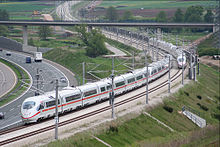Curve radius

The radius of a curve (in the railway system also curve radius ) is an important parameter for a sheet speed limit of a road or railway track. Tight curve radii mean a greater centrifugal force , which is why a route with flatter curves is necessary for higher speeds .
However, this brings increased difficulties in adapting the route to the terrain, especially on railway lines . If the maximum permissible curvature of the railway or road route remains noticeably below that of the contour lines of the terrain, increased costs arise for the construction of cuttings and dams .
For about 100 years, traffic routes have been routed in such a way that the straight sections do not directly merge into the curves, but transition arcs are arranged between them. As such, are often clothoids used so that the reciprocal of the turning radius , starting with zero, increases linearly. In a motor vehicle, this corresponds to a steadily increasing steering angle.
A certain curve radius and speed also include a suitable elevation of the curve in order to ensure sufficient lean angle and static friction of the vehicles. This superelevation must also increase from zero (in the straight line) to the current value at the apex of the curve with a suitable function in order to ensure good driving dynamics. The clothoid is also used for this increase in road construction, whereas the cubic parabola is used for railway lines .
Rail transport
In rail transport, the spectrum typical radii ranging from about 30 meters (with trams ) to several thousand meters (for example, new lines of high-speed traffic ). A curve becomes a straight line when its radius tends to infinity .
A smallest radius of 9 m is specified for the Lisbon tram with a narrow gauge of 900 mm. The Linz tram , which has the same narrow gauge , had a particularly narrow curve radius at the "bend" in Urfahr, line 3 shortly before the Mühlkreisbahnhof. Today this curve is used by the Pöstlingbergbahn , which has been re-tracked to 900 mm .
The smallest curve radii for standard-gauge (1435 mm) trams are 17.5 m for Graz and 20 m for Vienna, exceptionally 18 m. The Vienna underground has a minimum radius of 100 m on the U2 (Schottentor – Rathaus).
Local mountain railways have minimum curve radii of around 50 to 100 meters (e.g. Bernina Railway 45 m, Wengernalp Railway 60 m), and if they are of national importance with a higher expansion speed, they are around 200 m (e.g. Semmering Railway 190 m).
In Germany, with the new version of the Railway Construction and Operating Regulations in 1967, a new formula for calculating the permissible speed of trains in curved tracks was introduced:
With
- = Speed
- = Arc radius
- = Cant
- = Cant deficit
This increased the permissible speed in track curves and the permissible lateral acceleration from 0.65 m / s² to 0.85 m / s².
In 1925, the operating regulations (BO) provided for a fixed relationship between the radius of curvature and the permissible speed. The highest permissible speed, 120 km / h, required a radius of 1300 m on the main tracks, the lowest still permissible speed was 45 km / h (at 180 m radius).
Road traffic
In roads, the smallest radii often make sweeping switchbacks - on or built-up areas at about Abbiegerelationen at intersections or bypass a Gebäudeecks - more for the inner lane.
In the case of small radii, the trailing curve of the longest possible motor vehicle - bus, articulated truck, truck train - must be taken into account, which shows the increased width required along a curved path. In cramped parking spaces, front-steered vehicles are used to park backwards and forwards more efficiently. Rear view and reversing with single and especially double-articulated vehicle trains place higher demands on the driver.
In order for the static friction to be sufficient to generate the necessary centripetal force, the following inequality must be fulfilled (on a flat road):
Individual evidence
- ↑ Comparative values for the curve radius (railway) calculator for determining the maximum speed in curves, johannes-strommer.com, accessed January 25, 2020.
- ↑ § 40 (7) EBO.
- ^ Ernst Kockelkorn: Effects of the new railway building and operating regulations (EBO) on railway operations. In: The Federal Railroad . ISSN 0007-5876 , 13/14/1967, pp. 445-452.
- ↑ Erich Giese , Otto Blum , Kurt Risch: Linienführung (= Robert Otzen [Hrsg.]: Reference library for civil engineers . Volume 2 , no. 2 ). Julius Springer, Berlin 1925, p. 205 f .






